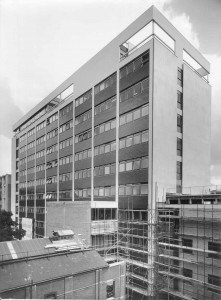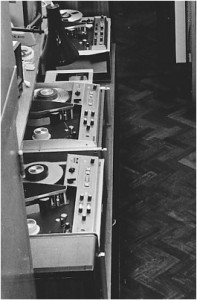
It’s not until you start to look at individual tapes in our archive that you realise how many different videos have, or could have, a link between them. In this latest blog I’ve found an example of that with two research videos made for the Electrical and Electronic Engineering Department ( Electrical Engineering Department as it was when these were made). We’ll also be seeing something of the actual department from the past. I should also point out that until 1976 were part of that department (a departmental facility) and as such located within the building. Our first location was on the 3rd floor moving to the main walkway level 2, where many of you may remember us.
In February 1981 Professor J.C Anderson (“Andy” Anderson 1922-2001) asked me to make a video showcasing the research in his Electrical Materials section within the department. I can’t recall the exact reason why we made the video, but am assuming it was to do with an open day, or similar, for Postgraduate research students, hence his references to getting PhD’s at the end of the video. The research going on at that time is shown and he makes reference to the work by Mino Green on Electrochromic Displays, but more on that in a moment.
Andy was very keen on the use of modern technologies for teaching, research and promotion and was the Chairman of the “Educational Technology Committee” (long since disbanded). It was his idea that I should be the only non-academic (although I was on the ‘academic related staff’) member of that committee to be able to update and advise on matters relating to the use of video within Imperial. He was not afraid to appear in front of the camera or, as in this case, record a voice-over as well. So here is the video we made with him: “Electrical Materials Research at Imperial College”
In the previous video, mention was made of the work by Professor Mino Green (1927-2022) (then Dr) on Electrochromic Displays. This work was already being carried out at the time of the previous recording. In fact the first video on Electrochromic Displays was made a year earlier in April 1980. We made some 7 videos on the subject with the last being in March 1993. I gather that Professor Green’s work has now moved away from such devices, but the concept was interesting and novel. The video itself is an example of how to show large numbers of people the research work being carried out by a small dedicated group. Even as long ago as 1980 we were having copies made into the American NTSC TV system to enable research work to be showcased in the USA, Mino Green’s was an example of this. Here is the video from 1993 on “Electrochromic Displays and Windows”.
Mino was an Emeritus Professor of the Science of Electrical Devices. His webpage described his work as “…The interplay of solid state physics and chemistry, particularly physical chemistry, has been an abiding interest. This has led through many areas, including semiconductor electrochemistry, chem- and physi-sorption on semiconductors, thermoelectric systems, solid state photo-and e-beam-decomposition, and transition metal oxide electrochromic systems. Now my main interests are in the larger end of nano-systems…”. In 1980 STOIC recorded an interview with Mino where he explains his area of research, you can see that video above.

Finally for this particular blog I’ve pulled something out of the archive from 1978 and you’ll see that in just a moment. It was a video made to showcase the whole department rather than a particular division or research project. Again, I can’t recall the exact reason why we were asked to make the video, but assume it was either an open day or event with alumni for example. Open day is more likely as the video is dated June 1978. It was a major task to make too, as editing was primitive on our old Ampex open spool one-inch tape machines. Nothing was automatic and edit points were marked with white (‘chinagraph’) wax pencils onto the tapes directly, spooled back and then run up to speed for editing. Recently I re-discovered a tape, made in 1974, where we are showing what the studio could do. So, before we see that 1978 video, here I am in our original TV Studio number 1, showing briefly the Ampex recorder in use, which I can assure you was as heavy as it looked!
At this time, we had no real means to record outside of the studio. One option though was to link from a location back to the studio by cable. And, because we were located in the Electrical Engineering, the whole building had video cables running from the ground, to top floors. We then had the ability to run from a location point on each main floor, down to the studio and potentially elsewhere. In the end, cables were available to and from many different buildings around the South Kensington campus. However, by this time we had already gained the ability to record outside of the studio having just moved into colour operation on the U-matic tape format. Portable battery operation was then made possible. The video that follows is an example of this.
So back then to the video I made for Electrical Engineering . The video did require a voice-over, but could I get anyone to volunteer to record it for me? Well the answer was no and being at a stage of needing to start the editing I had to do it myself. That aside, the video is a unique record of the department showing its teaching and facilities. I was asked to make specific reference to the fact that every lecture room was equipped with an ‘overhead projector’, how times have changed! The department also had its own glassblower, electronics servicing and draftsman. Here then is a snapshot (in black and white) of the department as it was in the early summer of 1978.
Colin Grimshaw May 2010
Hey Mr G – what was that portable reel to reel recorder you used to have? Was it full 625 lines?
MC
Hi Martin,
Glad you’re still reading my updates. I assume you are thinking of the Sony half-inch reel to reel recorder? It may have been the AV-3400 which came complete with its own black and white camera. And yes, it was 625 lines format.
If there are any’techies’ out there, you may be interested in this website of almost every video machine ever made. It includes the Philips EL3400 machine we once had here….it was full of valves (21 of them I believe) and got VERY hot during use!
http://www.rewindmuseum.com/reeltoreelvideo.htm
Keep reading my updates……
Hi Colin, Yes I am still alive!!! after 3 years of retirement. AMPEX I used to change and set up the heads on those m/cs for you and I still have the setting gauge I made 3’thou’ protrusion no more or tape would be cut to shreads!!!! Also a very abrasive green tape for head cleaning and various ‘fixing tools’
Be interested in more archive vids brings back memories.
Regards
David M Patrick (‘AVO DAVE’)
Hi Dave,
It’s great to hear from all those people, like you, who are reading these posts. Yes, those Ampex machines were VERY hard to set-up and to keep working 100%. Your green tape was called a ‘lapping tape’ if I recall, used to contour-in the head, before use. I parted with my last 1inch Ampex machine about 2 years ago, but it has gone to a good home that provides professional archival services on many of the tape formats used in the 1960’s to 1990’s.
These days we just pop a DVCam tape into a machine and out comes broadcast quality digital images. If not that, then a DVD. The latter being my normal archival back-up format for anything in our tape collection.
It was great to hear from you and I hope the video and pics of the Ampex machines brought back some memories of the times you serviced our machines. And I’ll take bets that may be you in the EED video adjusting the meter??
Colin Grimshaw
Hello Colin,
Very interested inreading your blog.
Congratulations on setting up the video archive, and for being at the TV Studio from the early days to its modern technological state.
Pity I missed your retirement, but hope you continue with your Blog?
Ed Bristow
Apologies Eddie that I have only recently spotted your comment on the blog. It was by chance that I happened to see a few recent comments added since I left Imperial.
We had an impressive ‘archive’ collection of recordings, mostly dating from the time we went into colour (c1979). Amazingly there continues an interest in Imperial-Past. The place has changed greatly since I started there and indeed even more since your time at Imperial. So, it’s nice to see -and hear- Imperial College from previous decades. The video on Electrical Engineering is an archive gem too. It captures a time in its history that will never be repeated.
I hope the blog may continue in the near future so alumni and staff can remember Imperial as it might have been when they were there. Also, the archive of STOIC is an untapped wealth of people, news, events and interviews all with key college staff and students. This is yet to see the light of day and there are LOADS of tapes too!!
“Our first location was on the 3rd floor moving to the main walkway level 2, where many of you may remember us.”
I remember that move very well. I spent much of the long vacation that year helping Colin Grimshaw move the studio from level 3 to level 2, enlarging and improving the facilities in the process.
Only just stumbled upon this blog. Colin, glad to see that you’re curating the archive and making it available. Don’t think I’ve got any material left from my days at IC. Possibly a VHS copy of the STOIC “Filmtalk” interview with Tim Curry but I’m sure you kept the 1″ tape of this.
Hi Jeff and thanks for your comments. It’s a bit of a task these days trying to get material into digital form. Firstly it takes time and secondly the machines are becoming difficult to maintain and spares are now almost impossible, even with u-matic format. As for one inch Ampex…well you can imagine that problem!
Recovering material from 1″ Ampex or IVC must be very difficult now. The machines were pretty temperamental in their heyday. I doubt there are more than one or 2 people in the UK who can do this now.
I did once try to play a 1″ tape, made on am Ampex 7003, on a C format machine. The basic video track layout is the same so I got some pictures. The control and audio tracks are swapped which didn’t help. Nor did the C format machine like tape without back coating.
Of course, needless to say, there are no spares in whole world for the original Ampex 1inch “A” format machines. I spoke a few months ago to our normal servicing company and there are now no more spares for our U-matics either. There are a few places in the USA and one in the UK that claim to be able to make 1inch Ampex “A” format transfers, but you can imagine the costs involved! Hard to think that only a matter of years ago we could easily have done all this within the TV Studio facilities…IF we had any form of digital encoding systems like mp2 or mp4.
I suspect that the boxes of STOIC Ampex 1inch tapes, with wonderful records of Imperial life from the 1970’s and 1980’s on them, may never be digitised.